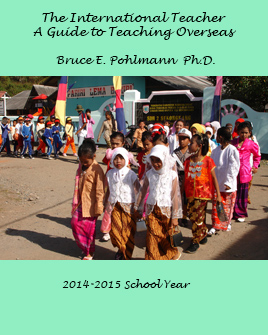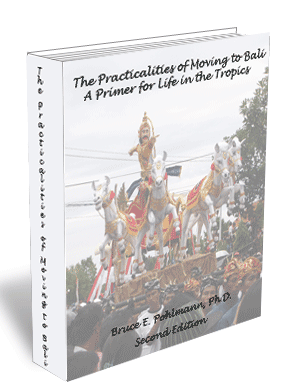Welcome to the Papua page
Papua is still relatively unexplored - new flora and fauna are still being discovered there. A tourist industry is being developed, but the island is relatively unstable politically from what my friends report. I spent nine years living in Irian Jaya, and I'll try to report my impressions from those nine years. There is so much to say, that I'm looking for the best format to organize all the information and photographs. Stay tuned as I get this all sorted out. In order to make this page fast-loading, I have made all the photograph thumbnails. If you want to see a larger, high resolution version, just click on the photograph. By downloading the photograph to your hard drive and opening it with a graphics editing program like Photoshop, you can see some quite interesting detail in a number of the photos.
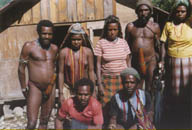 Irian Jaya (with the exception of the former
province of East Timor) was the last of the provinces to be added
to Indonesia. Located at the far eastern end of the archipelago,
Irian Jaya has been a problem for the Indonesian government since
it was annexed. Many of the Irianese (or West Papuans as many
of them preferred to be called) feel that they have little in
common with the rest of Indonesia. They look different, have distinctively
different cultures from what you find closer to Java, and are
sitting on a fortune in mineral resources which have been flowing
to Jakarta and the United States thanks to P.T. Freeport Indonesia.
Irian Jaya (with the exception of the former
province of East Timor) was the last of the provinces to be added
to Indonesia. Located at the far eastern end of the archipelago,
Irian Jaya has been a problem for the Indonesian government since
it was annexed. Many of the Irianese (or West Papuans as many
of them preferred to be called) feel that they have little in
common with the rest of Indonesia. They look different, have distinctively
different cultures from what you find closer to Java, and are
sitting on a fortune in mineral resources which have been flowing
to Jakarta and the United States thanks to P.T. Freeport Indonesia.
 I spent nine years living and working in Irian Jaya;
seven of those years were spent living in the highlands. The highlands
of Irian are breaktakingly beautiful, sometimes bleak, never easy
to live with the cool temperatures at night and the seemingly
neverending rainfall. Someone wrote a book
about living in the clouds, and it certainly seemed that way a lot
of the time. It's probably as close to heaven as I'll get.
I spent nine years living and working in Irian Jaya;
seven of those years were spent living in the highlands. The highlands
of Irian are breaktakingly beautiful, sometimes bleak, never easy
to live with the cool temperatures at night and the seemingly
neverending rainfall. Someone wrote a book
about living in the clouds, and it certainly seemed that way a lot
of the time. It's probably as close to heaven as I'll get.

The city of Tembagapura (literally copper town) was built in
the early 1970s by Freeport-McMoran. It was the first large foreign
project allowed in Indonesia after the havoc of the 1965-1966
change of government. Thus, Freeport developed a special relationship
with former President Suharto. That relationship has come to haunt
Freeport since the fall of Suharto.
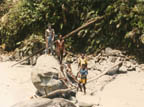 The rainforest up in the highlands is thick,
mountainous, rocky, and difficult to traverse. Rivers are everywhere.
Sometimes bridges were under construction and we just happened
to be lucky enough to find one already completed. Sometimes the
bridges had to be made as we went. Occasionally, we just hopped
across the river on boulders and hoped that we didn't fall in
the swift-flowing rivers. This bridge was already in place when
we came along. The guys are guides. Actually two of them (Yunder
and Yanius - more about them later) were our guides, the other
guys just tagged along until they reached their destination.
The rainforest up in the highlands is thick,
mountainous, rocky, and difficult to traverse. Rivers are everywhere.
Sometimes bridges were under construction and we just happened
to be lucky enough to find one already completed. Sometimes the
bridges had to be made as we went. Occasionally, we just hopped
across the river on boulders and hoped that we didn't fall in
the swift-flowing rivers. This bridge was already in place when
we came along. The guys are guides. Actually two of them (Yunder
and Yanius - more about them later) were our guides, the other
guys just tagged along until they reached their destination.
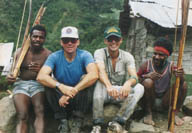 During the seven years that I lived in Tembagapura,
I went out every Saturday for a hike through the jungle. Almost
always with Yanius and Yunder, however in this photo we have Agus
and Nus. During my first two years, I was almost always accompanied
by my buddy Carl. After Carl left, Bruce (another Bruce) came
to work in Tembagapura, and he was my weekly companion. Here Carl
and I are resting in the village of Banti. During the first two
years that I was in Irian, there were no roads outside of Tembagapura
proper and the trek to Banti was challenging, especially at the
pace that Carl would set. Banti was a small village back in those
days. Since then Freeport has built a clinic and a school and
houses for the folks there. I haven't been in Banti for five years
now, so I'm not sure what it looks like.
During the seven years that I lived in Tembagapura,
I went out every Saturday for a hike through the jungle. Almost
always with Yanius and Yunder, however in this photo we have Agus
and Nus. During my first two years, I was almost always accompanied
by my buddy Carl. After Carl left, Bruce (another Bruce) came
to work in Tembagapura, and he was my weekly companion. Here Carl
and I are resting in the village of Banti. During the first two
years that I was in Irian, there were no roads outside of Tembagapura
proper and the trek to Banti was challenging, especially at the
pace that Carl would set. Banti was a small village back in those
days. Since then Freeport has built a clinic and a school and
houses for the folks there. I haven't been in Banti for five years
now, so I'm not sure what it looks like.
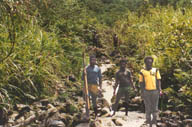 There was one trail that we particularly
were fond of (actually not me, but Bruce and Carl were)that was
dubbed the Killer Hill. This went straight up for over 1000 feet.
The guys here are doing their pose as we are just getting started
up the hill. I always hated the climb up the hill, but loved being
able to do it.
There was one trail that we particularly
were fond of (actually not me, but Bruce and Carl were)that was
dubbed the Killer Hill. This went straight up for over 1000 feet.
The guys here are doing their pose as we are just getting started
up the hill. I always hated the climb up the hill, but loved being
able to do it.
 Kids were a constant presence in the villages
and liked to travel along with us for a ways. Occasionally they
got to be pesty and the guys would shoo them away. Back in my
early days in Irian, not many bulai (Indonesian for a white person,
usually taken to be derogatory, but used in Irian generally the
same way that Balinese kids call foreigners "tourist") were out
in the rainforest in those days, so we were always good Saturday
entertainment.
Kids were a constant presence in the villages
and liked to travel along with us for a ways. Occasionally they
got to be pesty and the guys would shoo them away. Back in my
early days in Irian, not many bulai (Indonesian for a white person,
usually taken to be derogatory, but used in Irian generally the
same way that Balinese kids call foreigners "tourist") were out
in the rainforest in those days, so we were always good Saturday
entertainment.
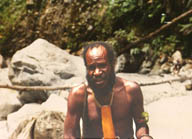 I used to run into this guy quite a bit during my
first two years in Irian. He always struck me as one of the most
dignified men that I've met.
I used to run into this guy quite a bit during my
first two years in Irian. He always struck me as one of the most
dignified men that I've met.
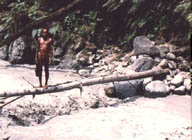 While bridges like this are necessary and
seemingly easy to cross if you notice the fellow on the bridge,
they were always a problem for me. My lack of balance on single
log bridges never improved over the years that I relied on these
bridges.
While bridges like this are necessary and
seemingly easy to cross if you notice the fellow on the bridge,
they were always a problem for me. My lack of balance on single
log bridges never improved over the years that I relied on these
bridges.
 This bridge looks fairly easy to use, but
in fact the logs were unevenly placed and the rope that served
as a handrail was almost completely useless except as an aid in
balancing. Yunder, of course, was always amused that I hated to
cross this bridge. If you notice in the large photo, the river
is filled with boulders and a fall would be extremely dangerous.
This bridge looks fairly easy to use, but
in fact the logs were unevenly placed and the rope that served
as a handrail was almost completely useless except as an aid in
balancing. Yunder, of course, was always amused that I hated to
cross this bridge. If you notice in the large photo, the river
is filled with boulders and a fall would be extremely dangerous.
 Dugouts like this one are used extensively in the lowlands.
They don't balance great either but do glide relatively smoothly
along the rivers. This boat had a baby shark still somewhat alive
sitting between the man and his wife and child. When I boarded
the boat, I almost sat on the shark. Ow!
Dugouts like this one are used extensively in the lowlands.
They don't balance great either but do glide relatively smoothly
along the rivers. This boat had a baby shark still somewhat alive
sitting between the man and his wife and child. When I boarded
the boat, I almost sat on the shark. Ow!
 These boys followed us one day through Banti and
back into the jungle where there were a few huts and some folks
that I had never met. People were constantly flowing into the
valley in search of work with Freeport.
These boys followed us one day through Banti and
back into the jungle where there were a few huts and some folks
that I had never met. People were constantly flowing into the
valley in search of work with Freeport.
 This young man wanted to sell several armbands that
he's holding. The bands were made out of a variety of materials.
Some of the older ones are made out of orchid fiber; newer ones
were made out of colored wire that the guys stole or scavenged
from Freeport.
This young man wanted to sell several armbands that
he's holding. The bands were made out of a variety of materials.
Some of the older ones are made out of orchid fiber; newer ones
were made out of colored wire that the guys stole or scavenged
from Freeport.
 These fellows lived in Kampung Baru. The fellow on
the right has a nice pair of Freeport boots. The one on the left
has some beads. The fellow on the left actually had a good sense
of humor.
These fellows lived in Kampung Baru. The fellow on
the right has a nice pair of Freeport boots. The one on the left
has some beads. The fellow on the left actually had a good sense
of humor.
 These two ladies are out enjoying a nice
day in the highlands. The lady in the top of the photo is holder
a salt container; the lady at the bottom of the photo has a very
nice nokin (net bag). These nokin are used to carry anything from
food, babies, and small pigs. The women can carry amazingly heavy
loads in these bags and run up the sides of steep mountains with
the bags on their backs.
These two ladies are out enjoying a nice
day in the highlands. The lady in the top of the photo is holder
a salt container; the lady at the bottom of the photo has a very
nice nokin (net bag). These nokin are used to carry anything from
food, babies, and small pigs. The women can carry amazingly heavy
loads in these bags and run up the sides of steep mountains with
the bags on their backs.
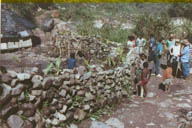 Close to the end of my second year in Irian, this
wall was constructed. The rock wall was something that I hadn't
seen in the valley before. It was washed away in a huge flood
several weeks later.
Close to the end of my second year in Irian, this
wall was constructed. The rock wall was something that I hadn't
seen in the valley before. It was washed away in a huge flood
several weeks later.
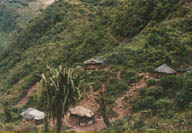 A view of some huts on the outskirts of a village
in the highlands.The insides of these huts were really smoky and
the folks and all of their stuff always had a smoky smell.
A view of some huts on the outskirts of a village
in the highlands.The insides of these huts were really smoky and
the folks and all of their stuff always had a smoky smell.
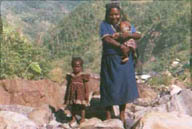 A woman with her two daughters on the trail
outside the village of Waa.
A woman with her two daughters on the trail
outside the village of Waa.
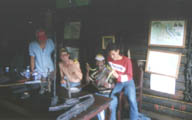 What do you do when you're a single guy living
in a mining camp in the middle of the rainforest? We built a place
called the Yacht Club. I'm here with the manager of the Yacht
Club and two of our employees. We have two young tree pythons
that we found on the grounds of the club. I took them up to Tembagapura
to show the students at the school and then returned them to the
rainforest.
What do you do when you're a single guy living
in a mining camp in the middle of the rainforest? We built a place
called the Yacht Club. I'm here with the manager of the Yacht
Club and two of our employees. We have two young tree pythons
that we found on the grounds of the club. I took them up to Tembagapura
to show the students at the school and then returned them to the
rainforest.
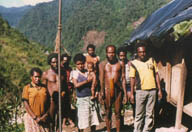 A group photo at Yanius' house out in the valley.
The woman holding the baby is Yanius' wife. Yanius has the number
12 shirt on. I'm not sure who all the rest of the people are other
than that they were related to Yanius.
A group photo at Yanius' house out in the valley.
The woman holding the baby is Yanius' wife. Yanius has the number
12 shirt on. I'm not sure who all the rest of the people are other
than that they were related to Yanius.
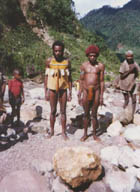 These two guys were selling the war vest that the
fellow on the left is wearing. The vest is quite sturdy and strong
enough to repel enemy arrows. Guys often showed up on the trail
on Saturdays to sell stuff to Carl and me. We were both collecting
bows and arrows in those days. Carl was especially known for his
fondness for boar's tusks.
These two guys were selling the war vest that the
fellow on the left is wearing. The vest is quite sturdy and strong
enough to repel enemy arrows. Guys often showed up on the trail
on Saturdays to sell stuff to Carl and me. We were both collecting
bows and arrows in those days. Carl was especially known for his
fondness for boar's tusks.
 We built the Yacht Club on the banks of
the Kaoga River in Timika. At the time that the Club was built,
there was nothing around it. Now this area is being rapidly developed.
Sundays were always busy at the Club: guys would come down from
Tembagapura to hang out, drink beer, take a swim and have a barbie.
We built the Yacht Club on the banks of
the Kaoga River in Timika. At the time that the Club was built,
there was nothing around it. Now this area is being rapidly developed.
Sundays were always busy at the Club: guys would come down from
Tembagapura to hang out, drink beer, take a swim and have a barbie.
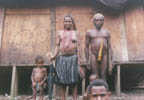 A Dani family in Kampung Baru.The woman's
skirt is made out of shredded up plastic - an innovation of the
area.
A Dani family in Kampung Baru.The woman's
skirt is made out of shredded up plastic - an innovation of the
area.
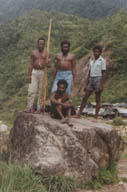 Paulus, Warananus and two other fellows. Paulus and
Warananus were two of my early buddies. Warananus was one of the
sweetest guys that I've ever met. He snuck into my apartment one
afternoon and saw a television for the first time
Paulus, Warananus and two other fellows. Paulus and
Warananus were two of my early buddies. Warananus was one of the
sweetest guys that I've ever met. He snuck into my apartment one
afternoon and saw a television for the first time
 An Irian hut. I found this one particularly interesting
because of the height that it was set above the ground. This is
unusual in this area.
An Irian hut. I found this one particularly interesting
because of the height that it was set above the ground. This is
unusual in this area.
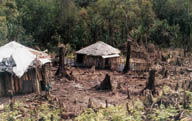 Some more Irian huts. You can see how these guys
use slash and burn to clear the forest when they build houses
and their gardens.
Some more Irian huts. You can see how these guys
use slash and burn to clear the forest when they build houses
and their gardens.
Papua Links
I've decided to start to add a few links to pages about Papua here since this page receives a fair amount of traffic - so there must be some interest about Papua.
![]() Papua Web , is "an information network for students, researchers, development workers, community leaders, government agencies and others working on issues relevant to Papua, Indonesia (formerly Irian Jaya). The University of Papua, Cenderawasih University and the Australian National University, the project hosts, welcome contributions of research materials to enhance the resources of this website."
Papua Web , is "an information network for students, researchers, development workers, community leaders, government agencies and others working on issues relevant to Papua, Indonesia (formerly Irian Jaya). The University of Papua, Cenderawasih University and the Australian National University, the project hosts, welcome contributions of research materials to enhance the resources of this website."
